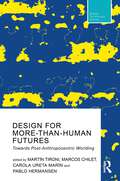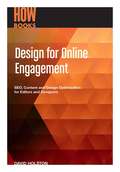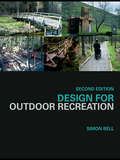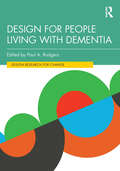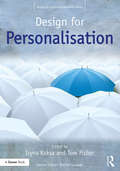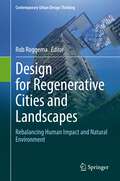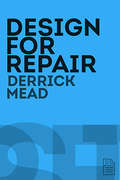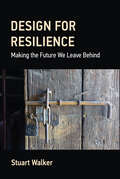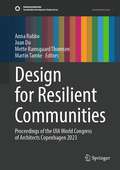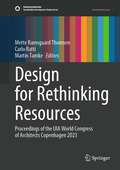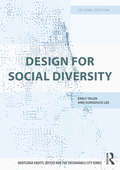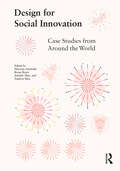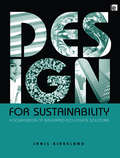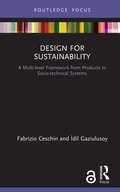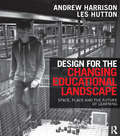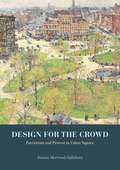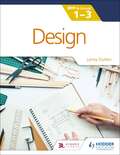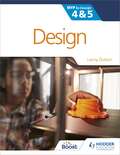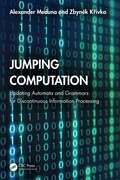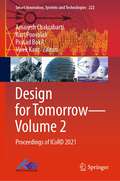- Table View
- List View
Design For More-Than-Human Futures: Towards Post-Anthropocentric Worlding (Routledge Research in Design, Technology and Society)
by Martín Tironi Marcos Chilet Carola Ureta Marín Pablo HermansenThis book explores the work of important authors in the search for a transition towards more ethical design focused on more-than-human coexistence. In a time of environmental crises in which the human species threatens its own survival and the highest level of exacerbation of the idea of a future and technological innovation, it is important to discard certain anthropocentric categories in order to situate design beyond the role that it traditionally held in the capitalist world, creating opportunities to create more just and sustainable worlds. This book is an invitation to travel new paths for design framed by ethics of more-than-human coexistence that breaks with the unsustainability installed in the designs that outfit our lives. Questioning the notion of human-centered design is central to this discussion. It is not only a theoretical and methodological concern, but an ethical need to critically rethink the modern, colonialist, and anthropocentric inheritance that resonates in design culture. The authors in this book explore the ideas oriented to form new relations with the more-than-human and with the planet, using design as a form of political enquiry. This book will be of interest to academics and students from the world of design and particularly those involved in emerging branches of the field such as speculative design, critical design, non-anthropocentric design, and design for transition.
Design for Motion
by Austin ShawPlumb the depths of core motion design fundamentals and harness the essential techniques of this diverse and innovative medium. Combine basic art and design principles with creative storytelling to create compelling style frames, design boards, and motion design projects. Here, in one volume, Austin Shaw covers all the principles any serious motion designer needs to know in order to make their artistic visions a reality and confidently produce compositions for clients, including: Illustration techniques Typography Compositing Cinematography Incorporating 3D elements Matte painting Concept development, and much more Lessons are augmented by illustrious full color imagery and practical exercises, allowing you to put the techniques covered into immediate practical context. Industry leaders and pioneers, including Karin Fong, Bradley G Munkowitz (GMUNK), Will Hyde, Erin Sarofsky, Danny Yount, and many more, contribute their professional perspectives, share personal stories, and provide visual examples of their work. Additionally, a robust companion website (www.focalpress.com/cw/shaw) features project files, video tutorials, bonus PDFs, and rolling updates to keep you informed on the latest developments in the field.
Design for Online Engagement: SEO, Content and Design Optimization for Editors and Designers
by David HolstonThe world changes on a daily basis. People's needs change, political, technical and social thinking changes, and your site will need to change to reflect the world around it. On a daily basis you need to be aware of any number of elements including strategy, brand, search, content, design, code, and measurement. And you need to be constantly checking to make sure you’re on course. The Web never sleeps, and neither should your site.
Design for Online Engagement
by David HolstonThe world changes on a daily basis. People's needs change, political, technical and social thinking changes, and your site will need to change to reflect the world around it. On a daily basis you need to be aware of any number of elements including strategy, brand, search, content, design, code, and measurement. And you need to be constantly checking to make sure you're on course. The Web never sleeps, and neither should your site.
Design for Outdoor Recreation
by Simon BellDesign for Outdoor Recreation takes a detailed look at all aspects of design of facilities needed by visitors to outdoor recreation destinations. The book is a comprehensive manual for planners, designers and managers of recreation taking them through the processes of design and enabling them to find the most appropriate balance between visitor needs and the capacity of the landscape. A range of different aspects are covered including car parking, information signing, hiking, waterside activities, wildlife watching and camping. This second edition incorporates new examples from overseas, including Australia, New Zealand, Japan and Eastern Europe as well as focusing on more current issues such as accessibility and the changing demands for recreational use.
Design for Pediatric and Neonatal Critical Care
by Mardelle McCuskey ShepleyDesign for Pediatric and Neonatal Critical Care provides an overview of the design and research issues associated with the development of environments for pediatric and neonatal intensive care. This is the first and only book dedicated to this topic and was created to support individuals interested in developing and studying critical care environments for children and their families. In addition to a detailed analysis of the literature from research and practice, the author provides a summary of the historical development of critical care for infants and children, and information regarding the role of PICUs and NICUs in the critical care system. A discussion of current codes and future trends is also provided. Design for Pediatric and Neonatal Critical Care includes essays from prominent voices in the field ranging from inspired young architects and researchers to world-renowned healthcare design and research icons. Illustrations of work that has been identified as exemplary or representative of recent directions are included, which will help those planning new or remodeled projects to identify and examine precedents. This book is intended to help designers and researchers enhance healing environments for young patients in critical care settings and provide information in support of the families and staff who provide care for these children and infants.
Design for People Living with Dementia (Design Research for Change)
by Paul A. RodgersThis book presents the latest research that shows how design thinking, making, and acting contribute to the co-designing and development of products, spaces, and services with people living with dementia. We know that there is currently no cure for the 130+ kinds of dementia that millions of people live with all over the world, but the designed interventions such as the products, spaces, and services described in this book can address stigma, isolation, loss of confidence, and raise awareness and greater understanding of dementia. This book showcases a range of innovative and creative design interventions that have been developed to break the cycle of well-established opinions, strategies, mindsets, and ways of doing that tend to remain unchallenged in the health and social care of people living with dementia. The book will be of interest to scholars working in product design, service design, experience design, architecture, design research, information design, user-centred design, and design for health.
Design for Personalisation (Design for Social Responsibility)
by Iryna Kuksa Tom FisherThe principle of personalisation appears in a range of current debates among design professionals, healthcare providers and educationalists about the implications of new technologies and approaches to consumer sovereignty for 'mass' provision. The potential of new technologies implies systems of provision that offer bespoke support to their users, tailoring services and experiences to suit individual needs. The assumption that individual choice automatically increases wellbeing has underlain the re-design of public services. Ubiquitous personalisation in screen-based environments gives individuals the sense that their personality is reflected back at them. Advances in Artificial Intelligence mean our personal intelligent agents have begun to acquire personality. Given its prevalence, it is appropriate to identify the scope of this phenomenon that is altering our relationship to the 'non-human' world. This book presents taxonomy of personalisation, and its potential consequences for the design profession as well as its ethical and political dimensions through a collection of essays from a range of academic perspectives. The thought-provoking introduction, conclusion and nine chapters present a well-balanced mixture of in-depth literature review and practical examples to deepen our understanding of the consequences of personalisation for our professional and personal lives. Collectively, this book points towards the implications of personalisation for design-led social innovation. This will be valuable reading for professionals in the design industry and health provision, as well as students of product design, fashion and sociology.
Design for Regenerative Cities and Landscapes: Rebalancing Human Impact and Natural Environment (Contemporary Urban Design Thinking)
by Rob RoggemaThis book discusses the way to design and plan for regenerative cities and landscapes. Where sustainability aims to safeguard the resources for future generations, and the resilience concept focuses on dealing with shocks to keep the system functioning, regeneration aims to give back more than it takes from the system. This principle is often used in analytical and assessment literature, but not yet elaborated in a spatial planning and design context, which this book does. It offers insights from a range of perspectives, spatial scales, such as the country level, neighbourhood public space, streets and the building levels, scientific fields and continents, amongst which Africa, Oceania, and Europe.
Design for Repair
by Derrick MeadRepair is a design constraint and an outcome of product design. It's also a practical activity performed--or not--on designed objects. Similar skills and understanding are required to design and fix things well, but these shared capacities are applied to very different practical ends. Design for Repair investigates the historical and current state of repair in material culture as it applies specifically to product designers.
Design for Resilience: Making the Future We Leave Behind
by Stuart WalkerA beautifully written and illustrated framework for resilient design that is as pragmatic as it is inspiring, showing us not only how but why we should design differently.Design for Resilience is a timely, visionary map for creating restorative design that addresses humanity&’s most critical issue: climate change. Our current wealth-oriented economic systems have resulted in gross disparities, war, refugee crises, and mass migrations that augur a bleak collective future. In this book, respected scholar Stuart Walker combines formidable research with practical examples to offer a hopeful, original, and transformative view of what resilient design looks like and how it can apply to all aspects of life, from personal objects to food to culture to business to recreation.Working at the intersection of theory, philosophy, history, environmentalism, and justice, Walker offers a fresh approach that decolonizes design thinking to fundamentally change the nature of design practice and how it shapes our lives, communities, and industries. Asking nothing short of the fundamental question &“How should we live?,&” Design for Resilience addresses the high-priority issues that concern governments, policymakers, designers, and people around the world who recognize that now, perhaps more than at any other time in human history, we need paradigmatic changes to create a future that lasts.
Design for Resilient Communities: Proceedings of the UIA World Congress of Architects Copenhagen 2023 (Sustainable Development Goals Series)
by Anna Rubbo Juan Du Mette Ramsgaard Thomsen Martin TamkeThe book provides new perspectives from leading researchers accentuating and examining the central role of the built environment in conceiving and implementing multifaceted solutions for the complex challenges of creating resilient communities, revealing critical potentials for architecture and design to contribute in more informed and long-term ways to the urgent transition of our society. The volume offers a compilation of peer-reviewed papers that uniquely connects knowledge and criticality broadly across practice and academia; from new technologies, theories and methods to community engaged practice on many scales, and more. The book is part of a series of six volumes that explore the agency of the built environment in relation to the SDGs through new research conducted by leading researchers. The series is led by editors Mette Ramsgaard Thomsen and Martin Tamke in collaboration with the theme editors: - Design for Climate Adaptation: Billie Faircloth and Maibritt Pedersen Zari - Design for Rethinking Resources: Carlo Ratti and Mette Ramsgaard Thomsen (Eds.) - Design for Resilient Communities: Anna Rubbo and Juan Du (Eds.) - Design for Health: Arif Hasan and Christian Benimana (Eds.) - Design for Inclusivity: Magda Mostafa and Ruth Baumeister (Eds.) - Design for Partnerships for Change: Sandi Hilal and Merve Bedir (Eds.)
Design for Rethinking Resources: Proceedings of the UIA World Congress of Architects Copenhagen 2023 (Sustainable Development Goals Series)
by Mette Ramsgaard Thomsen Carlo Ratti Martin TamkeThe book provides new perspectives from leading researchers accentuating and examining the central role of the built environment in conceiving and implementing multifaceted solutions for the complex challenges of our understanding of planetary resources and circularity, revealing critical potentials for architecture and design to contribute in more informed and long-term ways to the urgent transition of our society. The book offers a compilation of peer-reviewed papers that uniquely connects knowledge broadly across practice and academia; from the newest technologies and methods such as the role of digital modelling, analysis, and fabrication in circular design, i.e. material passports, cyber-physical augmentation, and LCA to the potentials of growing and harvesting biomass materials, engaging waste streams in material production and more, all in context of economic, social, and ecological potentials and consequences. The book is part of a series of six volumes that explore the agency of the built environment in relation to the SDGs through new research conducted by leading researchers. The series is led by editors Mette Ramsgaard Thomsen and Martin Tamke in collaboration with the theme editors: - Design for Climate Adaptation: Billie Faircloth and Maibritt Pedersen Zari - Design for Rethinking Resources: Carlo Ratti and Mette Ramsgaard Thomsen (Eds.) - Design for Resilient Communities: Anna Rubbo and Juan Du (Eds.) - Design for Health: Arif Hasan and Christian Benimana (Eds.) - Design for Inclusivity: Magda Mostafa and Ruth Baumeister (Eds.) - Design for Partnerships for Change: Sandi Hilal and Merve Bedir (Eds.)
Design for Social Diversity (Routledge Equity, Justice and the Sustainable City series)
by Emily Talen Sungduck LeeThe most successful urban communities are very often those that are the most diverse – in terms of income, age, family structure and ethnicity – and yet poor urban design and planning can stifle the very diversity that makes communities successful. Just as poor urban design can lead to sterile monoculture, successful planning can support the conditions needed for diverse communities. This new edition addresses the physical requirements of socially diverse neighborhoods. Using the city of Chicago and its surrounding suburban areas as a case study, the authors investigate whether social diversity is related to particular patterns and structures found within the urban built environment. Design for Social Diversity provides urban designers and architects with design strategies and tools to ensure that their work sustains and nurtures social diversity.
Design for Social Innovation: Case Studies from Around the World
by Mariana Amatullo Bryan Boyer Jennifer May Andrew SheaThe United Nations, Australia Post, and governments in the UK, Finland, Taiwan, France, Brazil, and Israel are just a few of the organizations and groups utilizing design to drive social change. Grounded by a global survey in sectors as diverse as public health, urban planning, economic development, education, humanitarian response, cultural heritage, and civil rights, Design for Social Innovation captures these stories and more through 45 richly illustrated case studies from six continents. From advocating to understanding and everything in between, these cases demonstrate how designers shape new products, services, and systems while transforming organizations and supporting individual growth. How is this work similar or different around the world? How are designers building sustainable business practices with this work? Why are organizations investing in design capabilities? What evidence do we have of impact by design? Leading practitioners and educators, brought together in seven dynamic roundtable discussions, provide context to the case studies. Design for Social Innovation is a must-have for professionals, organizations, and educators in design, philanthropy, social innovation, and entrepreneurship. This book marks the first attempt to define the contours of a global overview that showcases the cultural, economic, and organizational levers propelling design for social innovation forward today.
Design for Sustainability: A Sourcebook of Integrated Ecological Solutions
by Janis BirkelandWith radical and innovative design solutions, everyone could be living in buildings and settlements that are more like gardens than cargo containers, and that purify air and water, generate energy, treat sewage and produce food - at lower cost. Birkeland introduces systems design thinking that cuts across academic and professional boundaries and the divide between social and physical sciences to move towards a transdiciplinary approach to environmental and social problem-solving. This sourcebook is useful for teaching, as each topic within the field of environmental management and social change has pairs of short readings providing diverse perspectives to compare, contrast and debate. Design for Sustainability presents examples of integrated systems design based on ecological principles and concepts and drawn from the foremost designers in the fields of industrial design, materials, housing design, urban planning and transport, landscape and permaculture, and energy and resource management.
Design for Sustainability: A Multi-level Framework from Products to Socio-technical Systems (Routledge Focus on Environment and Sustainability)
by Fabrizio Ceschin İdil GaziulusoyThis book discusses the most significant ways in which design has been applied to sustainability challenges using an evolutionary perspective. It puts forward an innovation framework that is capable of coherently integrating multiple design for sustainability (DfS) approaches developed so far. It is now widely understood that design can and must play a crucial role in the societal transformations towards sustainability. Design can in fact act as a catalyst to trigger and support innovation, and can help to shape the world at different levels: from materials to products, product–service systems, social organisations and socio-technical systems. This book offers a unique perspective on how DfS has evolved in the past decades across these innovation levels, and provides insights on its promising and necessary future development directions. For design scholars, this book will trigger and feed the academic debate on the evolution of DfS and its next research frontiers. For design educators, the book can be used as a supporting tool to design courses and programmes on DfS. For bachelor’s and master’s level design, engineering and management students, the book can be a general resource to provide an understanding of the historical evolution of DfS. For design practitioners and businesses, the book offers a rich set of practical examples, design methods and tools to apply the various DfS approaches in practice, and an innovation framework which can be used as a tool to support change in organisations that aim to integrate DfS in their strategy and processes.
Design for the Changing Educational Landscape: Space, Place and the Future of Learning
by Andrew Harrison Les HuttonThe whole landscape of space use is undergoing a radical transformation. In the workplace a period of unprecedented change has created a mix of responses with one overriding outcome observable worldwide: the rise of distributed space. In the learning environment the social, political, economic and technological changes responsible for this shift have been further compounded by constantly developing theories of learning and teaching, and a wide acceptance of the importance of learning as the core of the community, resulting in the blending of all aspects of learning into one seamless experience. This book attempts to look at all the forces driving the provision and pedagogic performance of the many spaces, real and virtual, that now accommodate the experience of learning and provide pointers towards the creation and design of learning-centred communities. Part 1 looks at the entire learning universe as it now stands, tracks the way in which its constituent parts came to occupy their role, assesses how they have responded to a complex of drivers and gauges their success in dealing with renewed pressures to perform. It shows that what is required is innovation within the spaces and integration between them. Part 2 finds many examples of innovation in evidence across the world – in schools, the higher and further education campus and in business and cultural spaces – but an almost total absence of integration. Part 3 offers a model that redefines the learning landscape in terms of learning outcomes, mapping spatial requirements and activities into a detailed mechanism that will achieve the best outcome at the most appropriate scale. By encouraging stakeholders to creating an events-based rather than space-based identity, the book hopes to point the way to a fully-integrated learning landscape: a learning community.
Design for the Crowd: Patriotism and Protest in Union Square
by Joanna Merwood-SalisburySituated on Broadway between Fourteenth and Seventeenth Streets, Union Square occupies a central place in both the geography and the history of New York City. Though this compact space was originally designed in 1830 to beautify a residential neighborhood and boost property values, by the early days of the Civil War, New Yorkers had transformed Union Square into a gathering place for political debate and protest. As public use of the square changed, so, too, did its design. When Frederick Law Olmsted and Calvert Vaux redesigned the park in the late nineteenth century, they sought to enhance its potential as a space for the orderly expression of public sentiment. A few decades later, anarchists and Communist activists, including Emma Goldman, turned Union Square into a regular gathering place where they would advocate for radical change. In response, a series of city administrations and business groups sought to quash this unruly form of dissidence by remaking the square into a new kind of patriotic space. As Joanna Merwood-Salisbury shows us in Design for the Crowd, the history of Union Square illustrates ongoing debates over the proper organization of urban space—and competing images of the public that uses it. In this sweeping history of an iconic urban square, Merwood-Salisbury gives us a review of American political activism, philosophies of urban design, and the many ways in which a seemingly stable landmark can change through public engagement and design. Published with the support of Furthermore: a program of the J. M. Kaplan Fund.
Design for the IB MYP 1-3: By Concept
by Lenny DuttonEnsure your students navigate the MYP framework with confidence using a concept-driven and assessment-focused approach to Design, presented in global contexts. - Develop conceptual understanding with key concepts and related concepts, set in global contexts, at the heart of each chapter. -Prepare for every aspect of assessment using support and tasks designed by an experienced educator. - Extend learning through research projects and interdisciplinary opportunities. - Apply global contexts in meaningful ways with an internationally-minded perspective. - Develop practical and creative-thinking skills to solve design problems with a statement of inquiry in each chapter. - Confidently cover the framework with chapters covering digital, product and combined design.
Design for the IB MYP 1-3: By Concept
by Lenny DuttonEnsure your students navigate the MYP framework with confidence using a concept-driven and assessment-focused approach to Design, presented in global contexts. - Develop conceptual understanding with key concepts and related concepts, set in global contexts, at the heart of each chapter. -Prepare for every aspect of assessment using support and tasks designed by an experienced educator. - Extend learning through research projects and interdisciplinary opportunities. - Apply global contexts in meaningful ways with an internationally-minded perspective. - Develop practical and creative-thinking skills to solve design problems with a statement of inquiry in each chapter. - Confidently cover the framework with chapters covering digital, product and combined design.
Design for the IB MYP 4&5: By Concept
by Lenny DuttonEnsure your students navigate the MYP framework with confidence using a concept-driven and assessment-focused approach to Design, presented in global contexts. - Develop conceptual understanding with key concepts and related concepts, set in global contexts, at the heart of each chapter. -Prepare for every aspect of assessment using support and tasks designed by an experienced educator. - Extend learning through research projects and interdisciplinary opportunities. - Apply global contexts in meaningful ways with an internationally-minded perspective. - Develop practical and creative-thinking skills to solve design problems with a statement of inquiry in each chapter. - Confidently cover the framework with chapters covering digital, product and combined design.Table Content: Unit 1 Global Goals Design Challenge Unit 2 Design to help people express their emotions Unit 3 Playground design Unit 4 Lights change lives Unit 5 Service promotion Unit 6 Gamified exercise Unit 7 Pedestrian safety Unit 8 The importance of toilets Unit 9 Human impact animation Unit 10 Play with the past Unit 11 Dealing with change Unit 12 Turning drawings into products
Design for the IB MYP 4&5: By Concept (MYP By Concept)
by Lenny DuttonEnsure your students navigate the MYP framework with confidence using a concept-driven and assessment-focused approach to Design, presented in global contexts. - Develop conceptual understanding with key concepts and related concepts, set in global contexts, at the heart of each chapter. -Prepare for every aspect of assessment using support and tasks designed by an experienced educator. - Extend learning through research projects and interdisciplinary opportunities. - Apply global contexts in meaningful ways with an internationally-minded perspective. - Develop practical and creative-thinking skills to solve design problems with a statement of inquiry in each chapter. - Confidently cover the framework with chapters covering digital, product and combined design.Table Content: Unit 1 Global Goals Design Challenge Unit 2 Design to help people express their emotions Unit 3 Playground design Unit 4 Lights change lives Unit 5 Service promotion Unit 6 Gamified exercise Unit 7 Pedestrian safety Unit 8 The importance of toilets Unit 9 Human impact animation Unit 10 Play with the past Unit 11 Dealing with change Unit 12 Turning drawings into products
Design for the Unthinkable World: Strange Ecology and Unwelcome Change (Design Research for Change)
by Craig Bremner A. Paul Rodgers Giovanni InnellaThis edited book contests that if design’s raison d'être is to make things better, then the object of design has always been, remains and can only be a changed world and our relationship to it – the world-for-us.Each chapter was written by carefully selected researchers and practitioners who span geographical, disciplinary, and methodological boundaries in their work. Contributors skilfully examine the case that, while this once might have been seen to be a worthy objective (how else to effect a preferred state and/or pursue the project for the better world?), now the role of designing must cease to service design for change in the manner in which it has been doing. Chapters explore how designing itself might change to explore the possibilities that might exist for the design of what-might-not-become in an unthinkable-world; what Eugene Thacker calls a world-without-us. This world-without-us does not mean a world devoid of humans or an interstellar world, but a world we project that continues to revolve around the sun but no longer revolves around us.This book will be of interest to scholars working in design research, design ecology, product design, service design, experience design, architecture, and information design.
Design for Tomorrow—Volume 2: Proceedings of ICoRD 2021 (Smart Innovation, Systems and Technologies #222)
by Amaresh Chakrabarti Ravi Poovaiah Prasad Bokil Vivek KantThis book showcases cutting-edge research papers from the 8th International Conference on Research into Design (ICoRD 2021) written by eminent researchers from across the world on design processes, technologies, methods and tools, and their impact on innovation, for supporting design for a connected world. The theme of ICoRD‘21 has been “Design for Tomorrow”. The world as we know it in our times is increasingly becoming connected. In this interconnected world, design has to address new challenges of merging the cyber and the physical, the smart and the mundane, the technology and the human. As a result, there is an increasing need for strategizing and thinking about design for a better tomorrow. The theme for ICoRD’21 serves as a provocation for the design community to think about rapid changes in the near future to usher in a better tomorrow. The papers in this book explore these themes, and their key focus is design for tomorrow: how are products and their development be addressed for the immediate pressing needs within a connected world? The book will be of interest to researchers, professionals and entrepreneurs working in the areas on industrial design, manufacturing, consumer goods, and industrial management who are interested in the new and emerging methods and tools for design of new products, systems and services.
